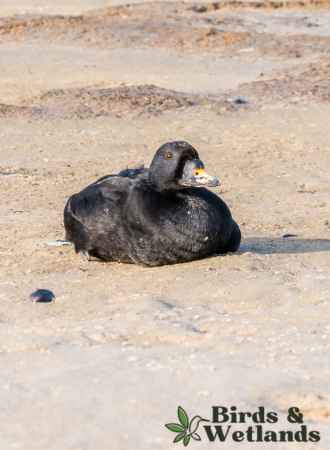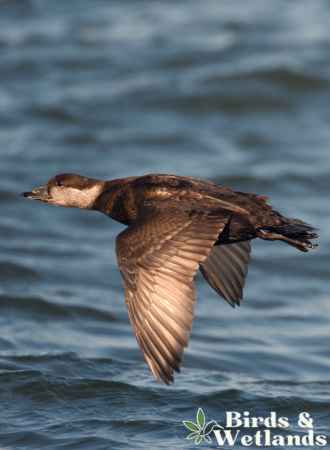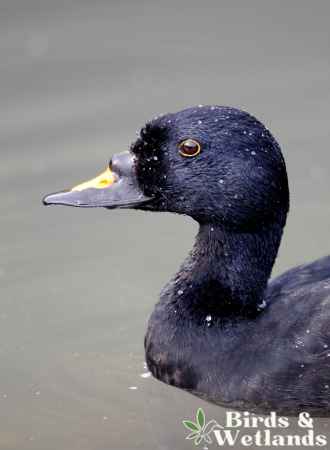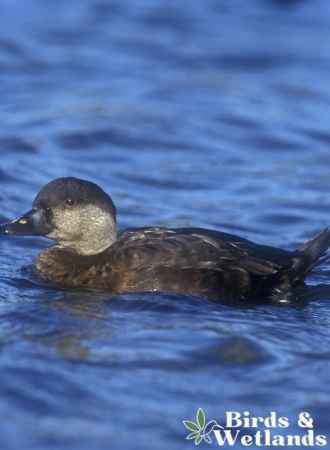
The common scoter is a large sea duck native to much of Europe and Asia. It breeds in many habitats, including tundra, bogs and marshes.
It is a member of the genus Melanitta, which is derived from the Ancient Greek word “melas,” which means “black,” and the Latin word “nitta,” which means “duck.” The species name “nigra” refers to the common scoter’s shining black plumage. Drakes of this genus are known for their black plumage, while females are mostly brown.
The common scoter is closely related to the black scoter of North America, which is similar in appearance and behavior. Both species are known for their striking black plumage and ability to dive underwater to forage for food.
Scientific Name: Melanitta nigra
Length: 430–550 mm (17–21.5 in)
Wingspan: 710 mm (28 in)
Weight: 950 g (2.09 lb)
History
In the early nineteenth century, scoters were accepted by the Roman Catholic Church as a good substitute for fish during Lent. These birds congregated on the western shores of France, where they were drawn to a particular species of small bivalve shell fish called vaimeaux.
Unfortunately, some ducks were caught in the nests, then sold to Roman Catholics who cooked and ate them along with a few others with the same fishy flavour on days when animal food was prohibited, such as Fridays during Lent.

Physical Description
The common scoter male boasts a shiny black exterior with a hint of violet-blue on the upper parts and a green gloss on the lower parts. His flight feathers are a dull, matte black, and the underwing is a more muted grey.
The broad bill is a striking black with yellow coloration on the knob and culmen, while his dark brown eyes stand out against his plumage. The legs and webbed feet are a greyish-black hue.
The adult female common scoter has a brownish-black crown and nape that contrasts with its paler cheeks, face, and neck, mostly greyish-brown to whitish.
Its body plumage is a deep, dark brown with a slight gloss on its breast and belly. The feathers also have paler brown tips that add to the bird’s overall appearance. Its flight feathers are dark brown with paler webs, and its bill is often dark, almost blackish. The common scoter’s eyes are brown, and its legs and feet are also black.
The lack of white from the drake and the absence of more extensive pale areas on the female are traits that set the common scoter apart from other species of scoters.

Listen to the Common Scoter
Common Scoter Population Distribution & Range
The Common Scoter is a sea duck species with a wide breeding range, including eastern Greenland, Iceland, northern Great Britain, and parts of Scandinavia and Northern Russia, including eastern Siberia. These ducks typically breed in areas with cold, harsh climates and access to bodies of water.
During the winter months, the Common Scoter migrates to more temperate regions, including the coastal waters of the Baltic Sea, the Atlantic coast of north-western Europe, and North Africa.
While they are not as common in these areas during migration, they can also be found on lakes in Central Europe, the western Mediterranean, the Black Sea, and the Caspian Sea.
This duck is a rare winter visitor in North America.

UK Population
A previously unknown wintering population of more than 50,000 birds on Shell Flat, located north west of England, was discovered by Cirrus Energy whilst surveying the area for the location of a proposed wind farm in 2003. The Northern Irish population, which peaked at 150-200 pairs in the 1970s, plummeted in the 1990s, and there were no confirmed breeding reports by 2010.
The UK government agreed in 1998 to implement a biodiversity action plan (BAP) to encourage the breeding population of the common scoter in the UK.
At the third steering group meeting of the UK Common Scoter Biodiversity Action Plan (BAP), the population in the Shell Flat area was estimated to be 16,500 wintering scoters and 5,000 birds in the molt stage.
Research on the decline of UK breeding pairs is being made.
Habitat
The common scoter has specific habitat preferences for both breeding and wintering, with a choice for open saltwater and shallow fresh water lakes during these respective seasons.
Common scoters are typically found in the Arctic tundra and sub-Arctic regions, breeding on freshwater lakes, pools, slow-flowing rivers, and streams. They need scattered trees and suitable nesting cover to breed successfully. However, they avoid wet areas surrounded by forests and steep slopes.
During the winter, common scoters can be found at sea, typically in shallow waters between 500 meters and 2 kilometers offshore. They rarely venture inland during this time, instead opting to molt and overwinter at sea. However, they may visit lakes and other inland waters during migration.
It’s important to note that common scoters prefer open salt water and avoid deeper waters, instead opting for relatively shallow lakes with a gross till or rock substrate. This behavior is because they primarily dive for food and are restricted to water less than 20 meters deep.

Feeding Habits & Diet
The common scoter is known for its opportunistic feeding habits, meaning it will eat whatever food sources are readily available in its environment. It primarily feeds on algae and aquatic insects like larvae, caddisflies, and mayflies in freshwater habitats, such as lakes, rivers, and streams.
However, when living in saltwater habitats, they mostly eat crustaceans like shrimp and crabs and mollusks like mussels. If small fish are present in their habitat, common scoters will feed on them too.
Common scoters are skilled divers, able to stay underwater for up to 30 seconds and reach depths of around 10 meters thanks to their webbed feet. These ducks forage for their favourite food by diving or upending underwater, searching for aquatic plants, insects, and mollusks.
Common scoters may feed alone or in small groups. During winter, when food is scarce, they often form larger flocks and work together to find sustenance. These large aggregations can often be observed off the coasts of Norway and Scotland as the ducks migrate south from their summer homes in more northern regions.

Nesting & Mating Habits
The common scoter engages in a regular reproductive cycle in the wild.
Pairs typically form during the late winter and early spring months, and the male scoters participate in elaborate courtship displays, which include a head stretch posture, a head shake, aquatic acrobatics, tail snap and aerial dives into the water. During this time, several males may court a single female.
The breeding season for common scoters usually begins in April and may last until June, although this timeline can vary depending on the specific region.
These birds tend to favor island locations in sheltered coastal bays or near inland wetlands as breeding grounds. The lined nest is usually constructed using various materials such as sedge grasses, mosses, leaves, feathers, and downy fluff. They may be lined with pebbles or small stones to provide insulation against cold weather and predators.
Clutch sizes for common scoters tend to range from 6 to 9 eggs per brood, and the incubation period lasts approximately 25 to 30 days before hatching begins. Males usually stay with their mates for the entire incubation period and then leave to join other males to molt.
Females assume the responsibility for caring for and feeding the young. Young common scoter can feed and search for their own foods hours after hatching. But they will continue following their mothers until they are abandoned and join other ducklings to form a creche.
Young ducks become full-fledged in 45 to 50 days from hatching. They reach sexual maturity at 2 to 3 years old.

Threats & Conservation
Due to their wide range, the common scoter is evaluated as “Least Concern.” However, populations of common scoters are declining where they occur.
Habitat destruction, oil spills, and other forms of pollution due to human activities are two of the main factors threatening this species, as they cannot survive in contaminated waters or landscapes that humans have altered.
In the UK, the small UK breeding population has been steadily declining, which prompted authorities to add these ducks to the Red List species. It is listed as a Schedule 1 species under the UK’s Wildlife and Countryside Act.
The common scoter is a species protected by the African-Eurasian Migratory Waterbirds Agreement (AEWA).
Key Points
- The common scoter is a dark seaduck that breeds far north of the Palearctic and northern Europe.
- Males are mostly black, while females and immature birds are dark brown with pale cheeks.
- In the winter, the common scoter forms large flocks of other scoters at their wintering grounds, including suitable coastal waters.
- This duck species dives underwater to forage food resources on the sea floor.
- This sea duck eats aquatic plants and small invertebrates.
